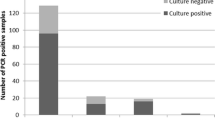Abstract
A new 5′-nuclease polymerase chain reaction (PCR) system for the detection and quantification of Citrobacter freundii and C. braakii was developed with primers and the probe oriented to a specific region of the cfa gene encoding a cyclopropane fatty acid synthase. The qualitative variant of the method consisted of a conventional PCR with end-point fluorimetry or agarose gel electrophoresis, and the quantitative variant used kinetic real-time PCR measurement. The PCR system was specific for C. freundii and C. braakii, detecting neither other Citrobacter spp. nor other enteric bacteria (Escherichia coli, Salmonella enterica, and others). The detection limit of the qualitative variant of the method was 103 cfu/mL when the amplification was followed by fluorimetry and 104 cfu/mL when the amplification was followed by gel electrophoresis. The real-time PCR variant of the method facilitated quantification over a range of concentrations from 102 to 108 cfu/mL, with Escherichia coli (106 cfu/mL) and Salmonella enterica (106 cfu/mL) having no effect on the quantification.



Similar content being viewed by others
Literature Cited
Abolmaaty A, El-Shemy MG, Khallaf MF, Levin RE (1998) Effect of lysing methods and their variables on the yield of Escherichia coli O157: H7 DNA and its PCR amplification. J Microbiol Meth 34:133–141
Guarino A, Giannella R, Thompson MR (1989) Citrobacter freundii produces an 18-amino-acid heat-stable enterotoxin identical to the 18-amino-acid Escherichia coli heat-stable enterotoxin (ST Ia). Infect Immun 57:649–652
Gupta R, Rauf SJ, Singh S, Smith J, Agraharkar ML (2003) Sepsis in a renal transplant recipient due to Citrobacter braakii. South Med J 96:796–798
Hodges GR, Degener CE, Barnes WG (1978) Clinical significance of Citrobacter isolates. Am J Clin Pathol 70:37–40
Li Y, Mustapha A (2004) Development of a polymerase chain reaction assay to detect enteric bacteria in ground beef. Food Microbiol 21:369–375
Maniatis T, Fritsch EF, Sambrook J (1982) Molecular cloning. New York: Cold Spring Harbor Laboratory
Rijpens NP, Herman LMF (2002) Molecular methods for identification and detection of bacterial food pathogens. J AOAC Int 85:984–995
Schmidt H, Montag M, Bockemühl J, Heesemann J, Karch H (1993) Shiga-like toxin II-related cytotoxins in Citrobacter freundii strains from humans and beef samples. Infect Immun 61:534–543
Štefanovičová A, Reháková H, Škarková A, Rijpens N, Kuchta T (1998) Confirmation of presumptive Salmonella colonies by the polymerase chain reaction. J Food Prot 61:1381–1383
Urbanová E, Páčová Z (1997) Identification of Citrobacter species and their occurence in raw products and foods (in Czech). Vet Med (Praha) 42:87–91
Acknowledgments
This research was financially supported by the Science and Technology Assistance Agency of the Slovak Republic, contract no. APVT-51-008902.
Author information
Authors and Affiliations
Corresponding author
Rights and permissions
About this article
Cite this article
Kaclíková, E., Krascsenicsová, K., Pangallo, D. et al. Detection and Quantification of Citrobacter freundii and C. braakii by 5′-Nuclease Polymerase Chain Reaction. Curr Microbiol 51, 229–232 (2005). https://doi.org/10.1007/s00284-005-4528-3
Received:
Accepted:
Published:
Issue Date:
DOI: https://doi.org/10.1007/s00284-005-4528-3




